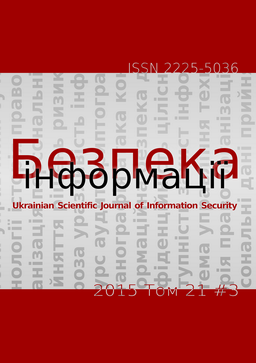Methods of detecting and analysis criminal networks based on billing information of cellular mobile operator
DOI:
https://doi.org/10.18372/2225-5036.21.9686Keywords:
detecting criminal networks, offender organizations, mobile phone networks, ranking nodes, destructive influence planningAbstract
Nowadays it is difficult to imagine a modern person without such means of communication as the Internet and mobile communications. Almost all modern crimes starting from preparation and to commitment are carried out by using electronic means of communication and leave heterogeneous traces in cyberspace. In accordance with the law some of these tracks are collected and accumulated by law enforcement agencies. Because of large volumes of data they can’t be processed manually. Not long ago a separate scientific direction – analysis of social networks, with analysis of criminal networks as a subdivision, appeared at the crossing of sociology and the theory of complex networks. This paper proposes the structure of expert system aimed at detection and analysis of organized criminal groups on the basis of automatic data processing of billing information of mobile operators. A method is proposed which allows identify criminal groups based on a pool of regular social contacts in telephone communication networks. The proposed method was tested in real social and criminal networks and results are given in this paper. Methods of effective destructive actions planning and implementation of active operational measures in relation to organized crime are described. In addition, the author proposes the method of disclosing internal structure of criminal networks, based on the modification of the famous search algorithm of relevant web pages.References
Travers, Jeffrey & Stanley Milgram. An Experimental Study of the Small World Problem, Sociometry, Vol. 32, No. 4, 1969, p. 425-443.
Barabasi, Albert-Laszlу and Reka Albert, Emergence of scaling in random networks, Science, 286, October 15, 1999, p. 509-512.
Sparrow M.K. The application of network analysis to criminal intelligence: An assessment of the prospects. Social Networks, 13(3), 1991, p. 251–274.
Arquilla J., Ronfeldt D. Networks and netwars: The future of terror, crime, and militancy. Survival, 44(2), 2001, p. 251–274.
Baker W., Faulkner R. The social organization of conspiracy: illegal networks in the heavy electrical equipment industry. Am. Social. Rev., 58, 1993.
Ferrara E., De Meo P., Catanese S., Fiumara G. Detecting criminal organizations in mobile phone networks. Expert Systems with Applications, 41(13), 2014, p. 5733–5750.
Klerks P., Smeets E. The network paradigm applied to criminal organizations: Theoretical nitpicking or a relevant doctrine for investigators. Connections, 24, 2001, p 53–65.
Krebs V. Mapping networks of terrorist cells. Connections, 24(3), 2002, p. 43–52.
Morselli C. Assessing vulnerable and strategic positions in a criminal network. Journal of Contemporary Criminal Justice, 26(4), 2010, p. 382–392.
Schneider F., Feldmann A., Krishnamurthy B., Willinger W. Understanding online social network usage from a network perspective. In Proc. 9th SIGCOMM conference on Internet measurement conference, 2009, p. 35-48.
Zang H., Baccelli F., Bolot J. Bayesian inference for localization in cellular networks. In 2010 Proceedings IEEE INFOCOM, IEEE, 2010, p. 1–9.
Xu J., Chen H. Criminal network analysis and visualization. Comm. ACM, 48(6), 2005, p. 100–107.
Yang C., Chen H., Hong K. Visualization of large category map for internet browsing. Decis. Support Syst., 35(1), Apr. 2003, pp. 89–102.
Yang C., Liu N., Sageman M. Analyzing the terrorist social networks with visualization tools. In Intelligence & security informatics, 2006, pp. 189–198.
Freeman L. Set of measures of centrality based on betweenness. Sociometry, 1977, p. 35–41.
Burt Ronald S. Structural Holes and Good Ideas. American Journal of Sociology, 110 (2), 2004, p. 349–399.
Ланде Д.В., Нечаєв О.О. Алгоритм ранжирування вузлів квазіієрархічних мереж соціального характеру // Проблеми інформатизації та управління, 49(1), 2015, С. 46-50.
Ланде Д.В., Нечаєв О.О. Відновлюваність зв’язків у безмасштабних мережах // Реєстрація, зберігання і обробка даних. – 2012. – Т. 14, № 3. – С. 92-98.
Zachary W. An information flow model for conflict and fission in small groups, Journal of Anthropological Research 33, 452-473 (1977).
Mehjabin Khatoon W., Aisha Banu A Survey on Community Detection Methods in Social Networks, I.J. Education and Management Engineering, 2015, 1, p. 8-18.
Каширин В. Анализ и моделирование криминальных сетей. – СПб НИУ ИТМО, «Итнернет и современное общество». – 2012. – 24 с.
Xiaomin Wang. Deciding on the type of the degree distribution of a graph (network) from traceroute-like measurements, 2011, International Journal of Computer Networks & Communications, vol. 4 (3), pp. 151-167.
Hamed Sarvari, Ehab Abozinadah, Alex Mbaziira. Constructing and Analyzing Criminal Networks,2014 , Security and Privacy Workshops, 84-91.
Nisha Chaurasia, Akhilesh Tiwari, Efficient Algorithm for Destabilization of Terrorist Networks, 2013, International Journal of Information Technology & Computer Scien;Nov2013, Vol. 5 Issue 12, p. 21.
Hyoungshick Kim, Ross Anderson, Temporal node centrality in complex networks, 2012, Computer Laboratory, University of Cambridge, 15, p. 85.
Carlos Garc´ıa C., Andreas Vost, Jochen Kogel, Distributed Anomaly Detection with Network Flow Data, 07.2015, Detecting Network-wide Anomalies, ISAR conference.
Vincent D. Blondel, Jean-Loup Guillaume, Renaud Lambiotte, Etienne Lefebvre, Fast unfolding of communities in large networks, Journal of Statistical Mechanics: Theory and Experiment, Vol. 2008, No. 10. - 243
U.S. Army Training and Doctrine Command, A Military Guide to Terrorism in the Twenty-First Century, 2008, Chapter 3, p. 1-14.
Kleinberg J. Authoritative sources in a hyperlinked environment // Proceedings of the ACM-
SIAM Symposium on Discrete Algorithms, Philadelphia, PA, 1998. – p. 668-677.
Barros J. Information Flows in Complex Networks, 2009, Information Theory and Statistical Learning, p. 267-287.

